Why Does My Car Not Start After Getting Gas?
A stuck open EVAP solenoid purge valve is the most likely issue of a car that won’t start after getting gas. When EVAP purge valve is stuck open, it causes a large amount of fuel to be sucked into the engine. It will disturb the air/fuel ratio of the combustion mixture and prevent the car from starting after getting gas. Another cause of car not starting after getting gas is improper tightening of a gas cap. Other things of stalling or sputtering car engine include clogged fuel injectors and failing fuel pump. If your check engine light is also on, you should get OBDII reader and pull all trouble codes to determine the root cause of car not starting after filling up the gas.
Getting gas for your car is usually no problem. But sometimes after filling up, your car just won’t start. Now what?
This simple guide can help if your car won’t crank after fueling up. We’ll list some typical causes and basic things to check so you can get going again.
Knowing some common issues means you can find what’s wrong and fix this frustrating problem yourself.
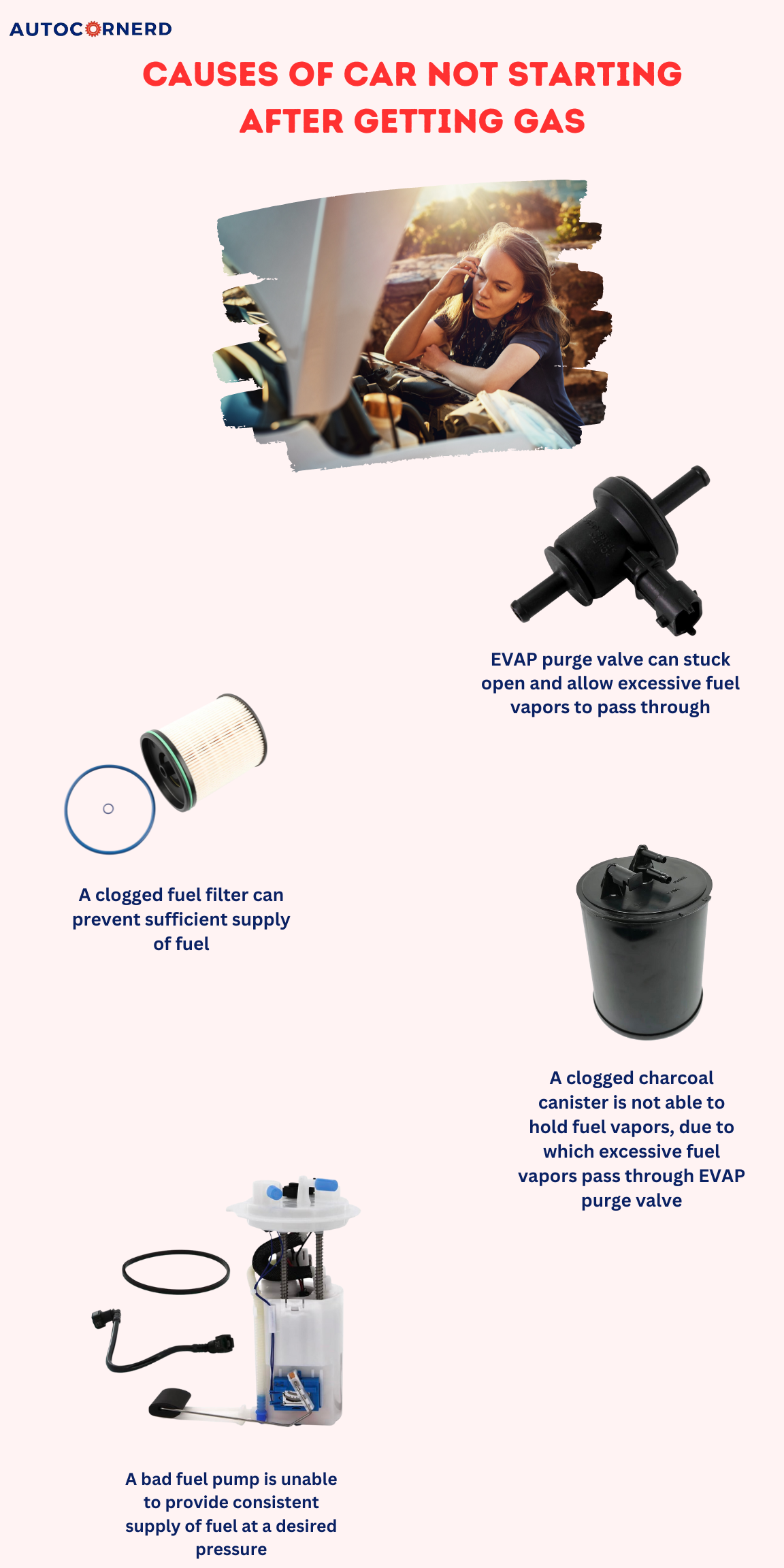
After spending tons of hours and reading suggestions by experienced people on relevant forums, I found that if your car sputters or takes multiple tries to start after getting gas then the problem most likely lies within the fuel system of the car, such as fuel injectors, fuel pump and fuel pressure regulator.
Are you experiencing sputtering in your car after refueling? Learn more by reading our guide on car sputtering after getting gas.
In the last section, I’ve included comments from forums where users share firsthand experiences with car not starting after getting gas. Be sure to check out that section for real insights.
- Your car might have a faulty or damaged gas cap if it is not starting after getting gas. If the gas cap is not creating a seal, this can cause the fuel sensor to detect an issue, potentially leading to starting problems.
- Overfilling the fuel tank can flood the EVAP system which is meant to control fuel vapors, causing the vehicle not to start.
- Your vehicle’s evaporative emissions system (EVAP) might be at fault. An error in the EVAP system, like a leak in the purge valve or a clogged charcoal canister, can prevent the engine from receiving the correct fuel mixture, causing starting issues.
- If your engine’s air-fuel mixture is incorrect, the engine might have starting problems or may stall immediately after starting. This might happen due to a faulty sensor, a broken fuel injector, or a damaged air intake system.
- Electrical issues like a dead battery, problems with your car’s alternator, or issues with the vehicle’s starter motor, can also prevent your car from starting after getting gas.
If you prefer a brief overview instead of reading the entire article, here is a summary table to quickly gather the information:
| Causes of Car Won’t Start After Getting Gas | Descriptions |
|---|---|
| EVAP Purge Valve Stuck Open | Allows too much fuel vapor into engine, causing overly rich air/fuel mixture so car won’t start. |
| Clogged Fuel Filter | Restricts fuel flow to engine, starving engine of fuel needed to run. |
| Faulty or Clogged Charcoal Canister | Unable to absorb fuel vapors, so vapors flood engine causing rich mixture. |
| Faulty Fuel Pump | Fails to pump enough fuel into engine for proper combustion. |
Note: If you don’t want to understand how the EVAP system works and want to know about the causes of car not starting after filling gas, you can jump straight to the section.
My Personal Experience With Car Not Starting After Getting Gas
My brother drives an older Nissan Altima that would stall out after filling up with gas. He asked me to take a look since I’m handy with cars. I started by testing fuel pressure and found it was very low.
After checking the fuse and relay, I suspected the fuel pump was failing. We dropped the gas tank and I tested power to the pump, which was good. But the pump made no noise when powered on.
Replacing the worn-out fuel pump for about $100 solved the stalling issue and now my brother’s Altima starts right up after gassing up.
How EVAP System Works?
Before diving into the causes of the car not starting after refilling the gas, it is quite important to understand how the EVAP system works. It will help you troubleshoot your problem.
EVAP system of an engine works by sucking extra fuel vapors from the canister through the purge valve to prevent leakage of fuel in the environment.
There are the following main components of EVAP system:
- Charcoal Canister
- Purge Valve
- Canister Vent Valve
- Fuel Tank Pressure Sensor
The schematic diagram of an EVAP system is shown in the figure below:
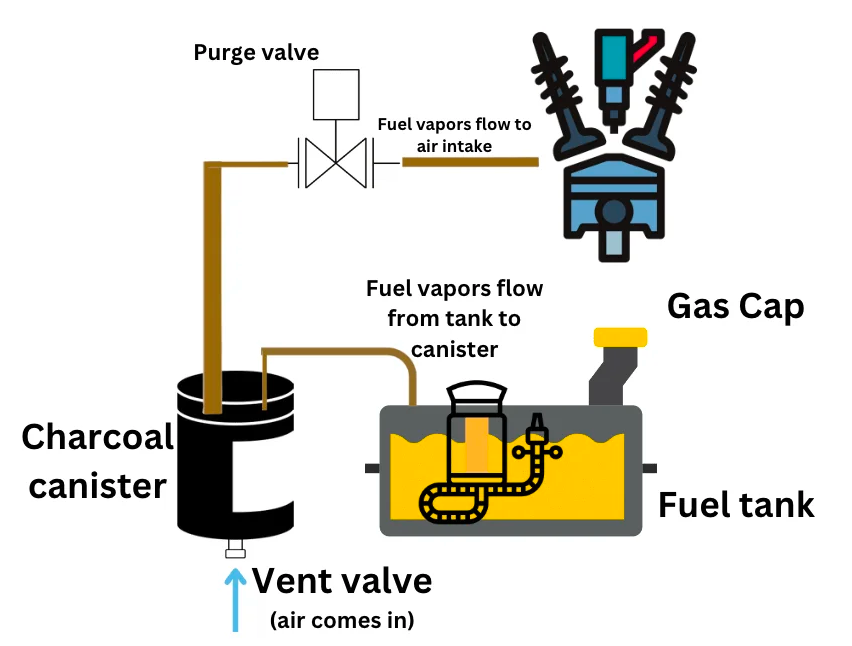
The powertrain control module (PCM) and engine control unit (ECU) are the same thing. Folks use these names interchangeably when talking about the computer brain of your car’s engine.
The canister is a small metal box filled with activated charcoal, like the charcoal in your barbecue grill but specially treated. It soaks up and traps fuel vapors so they don’t escape from your gas tank.
Your fuel tank has a pressure sensor that keeps an eye out for any big leaks. If it detects a leak, it sends an alert signal to the engine control module computer.
The purge valve is a one-way gate that only swings one way. It connects the charcoal canister to the engine’s air intake system. When the engine is off, the purge valve stays closed. Once you start the engine, the ECU computer slowly cracks open the valve bit-by-bit to let the trapped vapors into the engine.
The ECU opens the purge valve to create a vacuum. This vacuum pulls fresh air through the vapor canister. The fresh air forces the fuel vapors out. It delivers the vapors to the engine so they can burn during normal combustion.
The vent valve is another one-way solenoid valve connected to the canister. The vent solenoid valve is usually open. This lets air get drawn through the canister. There, it mixes with the vapor. Then, it gets pulled into the engine and burned.
If there is a big leak found in the EVAP system, the ECU will close the vent valve. This seals the system while it does self-diagnostics to find the big leak.
Causes of Car Not Starting After Getting Gas
Here are the causes:
1. EVAP Purge Valve is Stuck Open
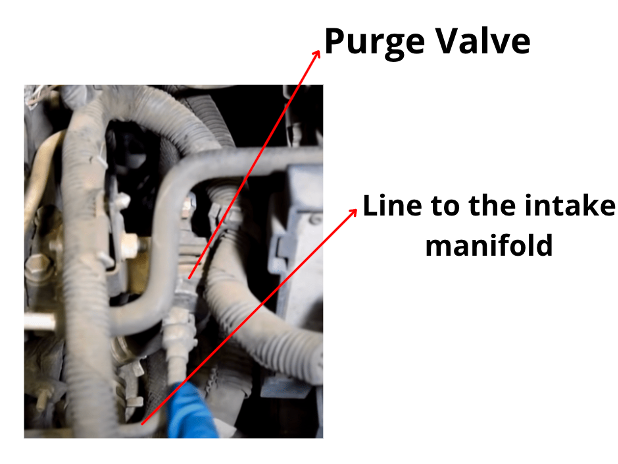
The EVAP purge valve has a very important job in your car’s fuel system. It helps get rid of fuel vapors from the charcoal canister and sends them to the engine to be burned up. This stops too many gases from building up in the fuel tank.
Sometimes the EVAP purge valve can get stuck open. When you fill up your gas tank, vapors quickly build up. If the valve is stuck open, way more vapors than normal will go past into the intake.
When you restart the engine after filling up, there is too much fuel compared to air. The mixture is too rich to ignite well. Unburnt fuel remains. This makes the engine real hard to start after a fill-up.
Pressing the gas pedal halfway can help it start. This brings in more air to help the mixture ignite. If this trick works, your purge valve likely needs replacing.
To diagnose a faulty purge solenoid valve, you can do the following steps:
- Locate the purge valve by taking help from the owner’s manual.
- Bypass the purge valve by temporarily disconnecting it from the intake manifold. Now, start the car. If the car readily starts, it means that the purge valve is faulty.
- Next, remove the purge valve from the car. You either need a spanner/screwdriver to remove the purge valve or you can simply remove it by rotating it anticlockwise with your hands.
- After removing the purge valve, if you can blow through it in either direction it means that the purge valve is confirmed faulty.
- Another bulletproof test you can do to diagnose the purge valve is to pull the vacuum on the side of the purge valve that goes to the intake manifold through the vacuum pump. This is the same side of a purge valve through which the intake manifold of the engine creates the vacuum to suck fuel vapors from the canister. If the purge valve is not holding a vacuum, it means that the purge valve is faulty.

Check out the below video for a diagnostic test of a purge valve.
2. Clogged Fuel Filter Prevents Fresh Gasoline From Reaching Engine During Ignition
The fuel filter removes dirt and water from fuel before it enters the engine. This protects the engine from harm.
If your car won’t start after filling up with fuel, the fuel filter might be clogged. A clogged filter doesn’t allow fuel to pass through easily. This can stop the engine from starting.
A clogged fuel filter can also cause lower engine power. It can make the engine run rough too. Fuel might not flow smoothly to the engine with a clogged filter.
How to test?
Before attempting this test, be sure to drain all gasoline from the fuel filter to avoid any potential hazards.
For the test, you’ll need a straw (to avoid ingesting gasoline) and the fuel filter itself.
- Slide the straw over the inline connection, carefully ensuring a tight connection that won’t obstruct airflow.
- Blow into the straw and observe if the air flows through the filter effortlessly or encounters obstruction.
If air flows through the fuel filter without any hindrance, the fuel filter is in good condition. However, if the airflow is slow or blocked, it indicates a faulty fuel filter that needs to be replaced.
3. Faulty or Clogged Charcoal Canister Unable To Trap Fuel Vapors
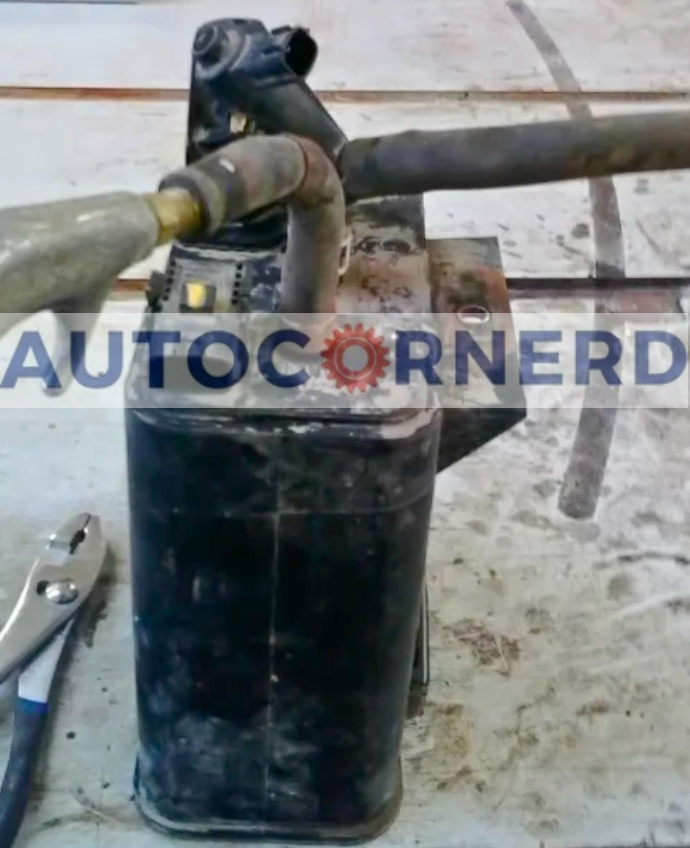
The charcoal canister is an important part of your car’s fuel system. Its job is to trap fuel vapors from the fuel tank. This keeps the vapors from escaping into the air or flowing back into the tank.
A clean canister filled with fresh activated charcoal does this job well. But over time, dirt and grime can clog up the charcoal bed. When this happens, fuel vapors can’t get absorbed properly.
Instead, the vapors have nowhere to go. They flow backwards into the fuel tank. There, they cause pressure buildup. This makes it hard to refill the tank. It can take several tries to start the engine after getting gas.
Here is a simple way to check if your charcoal canister is faulty:
- First, find the charcoal canister. It is usually connected by a hose to the purge valve under the engine.
- Inspect the canister for any cracks or damage.
- Remove it from the engine compartment.
- Attach a hose to the bottom port that connects to the fuel tank.
- Blow air through the hose.
- If the air doesn’t come out of the other ports, the charcoal inside is likely clogged. This confirms the canister is bad and needs to be replaced.
Check out the below video to understand how to remove the charcoal canister.
4. Faulty Fuel Pump Preventing Pressurized Fuel Delivery
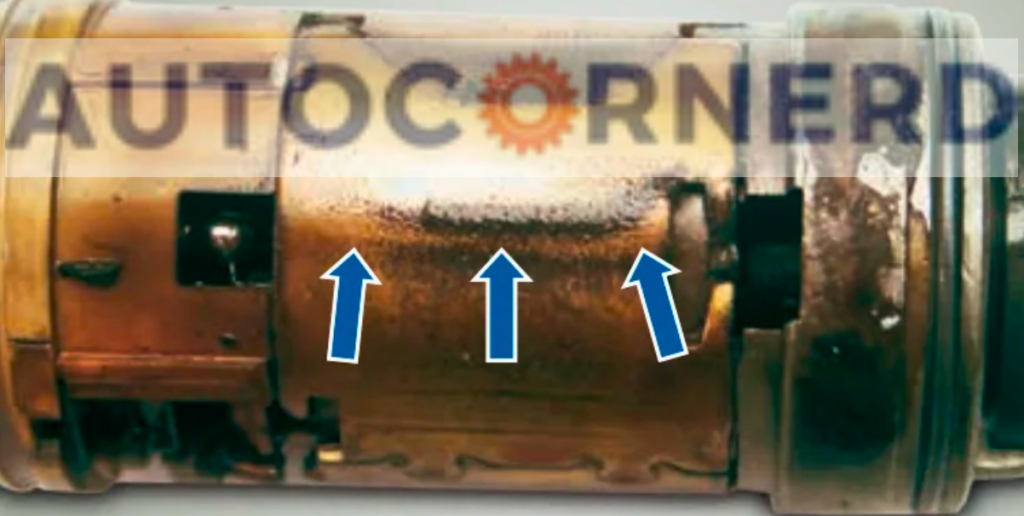
The fuel pump has an important job. It moves fuel from the car’s tank to the engine. The engine uses the fuel to make power so the car can move.
If the fuel pump breaks down, fuel stops flowing to the engine. Then the engine can’t get the fuel it needs to make power and work right.
One reason a bad fuel pump can make a car sputter right after adding gas is something called “vacuum in the air space”.
If the gas tank can’t vent air well, a vacuum happens in the empty space above the fuel. The vacuum causes problems for the fuel pump. It can’t pull in enough fuel. So the car sputters.
Also, when you fill up the tank, any grit or bits already in there mix into the new gas.
As the fuel level rises during refilling, any debris present in the bottom of the tank will float to the top and become incorporated into the gas. If the fuel pump assembly is damaged or worn, it may have difficulty drawing the fuel from the tank if debris is present. Small pieces of grit or sediment can potentially limit the fuel pump’s ability to properly pump fuel into the engine.
Fuel pumps do not last forever. That’s why vehicle manufacturers recommend replacing a fuel pump after every 60,000 to 100,000 miles.
To learn more you can read my guide on common problems after changing fuel pump.
Here are the symptoms of a faulty fuel pump in a vehicle’s engine:
- Sputtering noise of car when speed is high
- Whining noise from the fuel tank
- Engine is starved for fuel when accelerating
- Reduced gas mileage
- The whining noise of a fuel pump can be heard when you turn on ignition key without starting the engine
If your car is losing power when turning corners, be sure to check out that guide as well.
Here is how to diagnose a fuel pump:
- Turn the ignition on
- Open the gas cap of the fuel tank
- If you do not hear the sound from the fuel tank, it could mean the fuel pump is not running
- Now, turn the ignition off
- Locate the fuse box and find the fuse for the fuel pump with the help of the fuse box layout diagram of your vehicle
- If the fuse of the fuel pump is fine, check the relay of the fuel pump in the fuse box
- If the relay clicks, it means that it is fine
- Now, turn on the ignition
- Next, check the pressure of fuel using the fuel pump pressure test kit. You can read my guide on bad fuel pressure regulator symptoms to learn more
- Locate the test port on the fuel line
- Fit down the hose of a pressure test kit on the test port
- If there is no fuel pressure on the test gauge, it means that the fuel pump needs to be replaced
Check out the below video to understand how to diagnose the fuel pump.
Here is how to check fuel system pressure:
5. Fouled Spark Plugs Unable to Combust Fuel
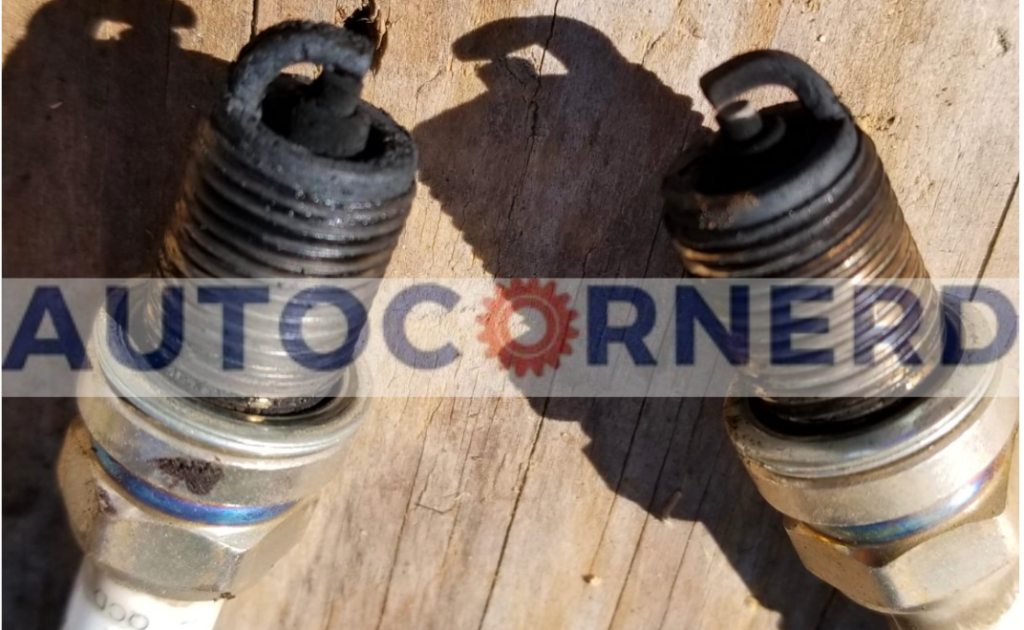
Spark plugs give the spark to ignite the fuel-air mix in your engine’s cylinders. But over time, spark plugs can get dirty or damaged. This is called fouling. Fouled plugs can’t spark right to fire the engine.
Spark plugs can fail due to following reasons:
- Oil Fouling: Oil leaking past worn rings or seals can coat the plugs. This oil stops the spark from jumping across the gap.
- Fuel Fouling: Unburned gas, carbon, and additives leave deposits on plug tips. These block the spark, especially if engine often runs rich or idles a lot. Fuel-fouled plugs look dry and black.
- Coolant Fouling: Coolant from a blown head gasket or cracked block can get on plugs. Chemicals and minerals in coolant leave white chalky build-up on plugs.
- Corrosion Fouling: Contamination, improper additives, or weak ignition voltage can corrode plug electrodes over time. This widens the gap needed to spark.
- Ash Deposits: Oil and fuel additives with phosphorus or zinc leave ash deposits on plugs. This ash insulates the plugs from sparking correctly.
How does it affect car starting?
Spark plug fouling is a common reason that vehicles fail to start after refueling. One common scenario is when you fill your gas tank to the brim, excessive fuel can leak through the fuel injectors.
The leaky fuel injectors may drip gasoline into the cylinders even when the engine is off. This leaves puddles of fuel that foul the spark plugs. When the ignition is engaged, the plugs fail to fire because they are smothered with gasoline. This causes a no-start condition.
How to fix?
The first solution is to clean spark plugs properly. First, blow away dirt and junk using compressed air. After that, soak the spark plug in brake cleaner until all the gunk is gone. You can also use a soft brush to get rid of any remaining debris.
Next, you should check fuel pressure regulator. It has a diaphragm that gets ruptured, due to which fuel pressure regulator is unable to maintain fuel pressure. It will cause excessive fuel to flow through the fuel pressure regulator which will foul the spark plugs.
In my guide on how fuel pressure regulator can fail, I have explained everything about this. So, you can check it out there.
Lastly, check fuel injectors. They have O-rings to prevent fuel leakage directly into the engine cylinders. If the O-rings are broken, fuel will drip into the combustion chamber and foul the spark plugs.
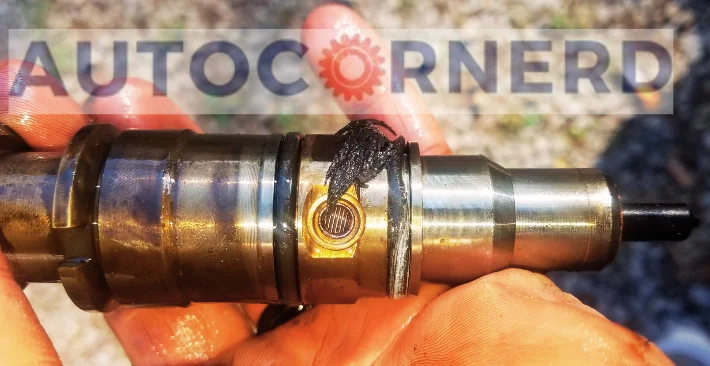
Car Won’t Start After Getting Gas: Final Thoughts
To recap why the car is sputtering or not starting after getting gas, here are the following causes:
- EVAP Purge Valve is Stuck Open
- Clogged Fuel Filter
- Faulty or Clogged Charcoal Canister
- Faulty Fuel Pump
Some First Hand Experiences Shared By Users In Different Communities
Our team conducted research across various online communities, forums, and subreddits to gather user comments and opinions on “car not starting after getting gas”.
User 1 says:
In my case, with a 2017 Nissan Rogue, the car wouldn’t start after getting gas. The issue turned out to be a defective fuel tank pressure sensor. It was not properly regulating the pressure inside the tank, leading to starting problems. Replacing this sensor fixed the issue for me.
User 2 says:
My 2018 Volkswagen Tiguan had a starting issue after fueling. After several checks, I realized the problem was with the fuel cap. It wasn’t sealing properly, causing pressure issues in the fuel tank. Replacing the fuel cap with a new one resolved the issue. Sometimes the simplest components can cause significant problems.
User 3 says:
I had a similar issue with my 2017 Jeep Cherokee. It turned out to be a problem with the EVAP purge solenoid. It was sticking, causing the engine to flood with fuel vapors. Replacing the solenoid fixed the starting issue after refueling. It’s a common problem in many Jeep models.
User 4 says:
I had a similar issue with my 2015 Ford Fiesta. Every time I got gas, it just wouldn’t start. After doing some research and checking the car, I found out that the problem was with the EVAP canister. It was clogged and needed replacing. Once I did that, the car started perfectly after fueling. If you’re facing a similar issue, I’d suggest checking the EVAP system.
FAQs About Car Won’t Start After Getting Gas
Why does my car sputter after getting gas?
A car sputters after getting gas because the vehicle is having problems with the fuel system. Dirt and debris can enter the system through the fuel filter, pump, or fuel injectors. When this happens, the engine runs inefficiently and sputters.
How do you prime a fuel pump after running out of gas?
The best way to prime a fuel pump is to turn the ignition key on after filling the tank. Wait for few minutes. Turn off the ignition. Again wait for around 2 minutes, and turn on the ignition. Repeat this procedure a couple of times to successfully prime the fuel pump. Priming a fuel pump make sure there is adequate pressure in the fuel line from your gas tank all the way to the fuel injectors.
Why does my car stall after getting gas?
If your car stalls or shuts off immediately after getting gas, it could be due to a problem with the evaporative emissions control system (EVAP). The EVAP system is responsible for preventing fuel vapors from escaping into the atmosphere. If there is a malfunction in this system, it can cause the engine to stall after refueling. It’s recommended to have a mechanic inspect and repair any issues with the EVAP system.
What are some other reasons why my car won’t start after refueling?
Aside from fuel system issues, there are other potential reasons why your car won’t start after refueling. It could be a problem with the ignition system, such as a faulty ignition switch or a malfunctioning ignition coil. It could also be an issue with the electrical system, such as a dead battery or a faulty starter motor. Additionally, a malfunctioning engine control module (ECM) or a faulty crankshaft position sensor can also prevent the car from starting.
Can a loose fuel cap cause my car to not start after getting gas?
Yes, a loose fuel cap can potentially cause your car to not start after getting gas. A loose or improperly sealed fuel cap can lead to a drop in fuel pressure, which can affect the engine’s ability to start. Always ensure that the fuel cap is tightly closed after refueling to avoid this issue.
